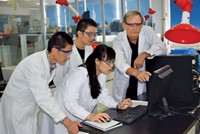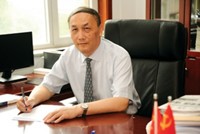Advertisement
Grab your lab coat. Let's get started
Welcome!
Welcome!
Create an account below to get 6 C&EN articles per month, receive newsletters and more - all free.
It seems this is your first time logging in online. Please enter the following information to continue.
As an ACS member you automatically get access to this site. All we need is few more details to create your reading experience.
Not you? Sign in with a different account.
Not you? Sign in with a different account.
ERROR 1
ERROR 1
ERROR 2
ERROR 2
ERROR 2
ERROR 2
ERROR 2
Password and Confirm password must match.
If you have an ACS member number, please enter it here so we can link this account to your membership. (optional)
ERROR 2
ACS values your privacy. By submitting your information, you are gaining access to C&EN and subscribing to our weekly newsletter. We use the information you provide to make your reading experience better, and we will never sell your data to third party members.
Policy
For Gathering Storm, Clouds Ahead
China must overcome significant challenges to become the innovative scientific powerhouse it wants to be
by Jessie Jiang
December 13, 2010
| A version of this story appeared in
Volume 88, Issue 50

The U.S.’s position as the world’s scientific powerhouse is increasingly in peril, and China is positioning itself as usurper—such was the gloomy picture portrayed in “Rising Above the Gathering Storm, Revisited,” the report published this fall by the National Academies (C&EN, Oct. 4, page 7). But can China really muster the Category 5 storm that report portends?
Now the world’s second-largest economy, China certainly has an ambitious agenda. It wants to become an innovation-driven country by the end of 2015, according to Wan Gang, the minister of science and technology who declared the goal in several public speeches in China in October. And China’s ambition is not so far-fetched. In 2008, Chinese researchers published a total of 112,000 Thomson Reuters-indexed papers, making China, for the first time, the world’s second-largest producer of academic papers, according to a global research report published by Thomson Reuters in 2009. China contributed nearly 17% of all papers in chemistry during 2004–08, nearly doubling its share from the preceding five-year period, the report says. According to the American Chemical Society’s Chemical Abstracts Service, China’s patent office is projected to publish nearly 100,000 chemical patent applications this year, more than twice as many as the U.S. Patent & Trademark Office.
Correspondingly, China has also experienced phenomenal growth in research funding throughout the past decade. In 2008, China’s gross domestic spending on R&D reached $68.9 billion, a 24% increase from the previous year. In 2009, its central government earmarked $3.3 billion for scientific and technological research, a 22% jump from 2008’s $2.7 billion. According to government figures, research funding from the National Natural Science Foundation of China (NSFC) and the Ministry of Science & Technology each increased at an annual rate of more than 20% over the past five years. With the drastic boost in government funding, China has also launched a series of programs to lure established overseas scientists back home, in an effort to foster indigenous research innovation.
Despite China’s now massive output of academic papers and its dramatic increase in research funds, some prominent local scientists warn that their country faces significant problems that could jeopardize its innovative potential.
“Much like our country’s economic growth, I think our scientific and technological development has also reached a stage that calls for a shift in strategy,” says Song Gao, dean of the college of chemistry and molecular engineering at Peking University, one of China’s top chemical research institutions. “We now have to focus more on the originality and depth of research, instead of just the quantity.”
He and other chemists that C&EN spoke with say China could promote research originality by ceasing to rely so heavily on the number of papers generated and the impact factors of the journals in which those papers are published when evaluating its scientists.

Meanwhile, China is seeking to boost its research originality by recruiting talented scientists from overseas. Through a government-sponsored project ambitiously titled the Thousand Talents Program, China has attracted more than 800 researchers and entrepreneurs since late 2008, offering them key positions at some of the nation’s top research universities. And in the next five to 10 years, the official plan is to land another 1,200. Prior to that, China had launched several similar programs on a smaller scale, including the Chinese Academy of Sciences’ Hundred Talents Program, the Changjiang Scholars Program, and NSFC’s Distinguished Young Scholars program.
Despite its impressive recruitment figures, the Thousand Talents Program has not gone without criticism—mostly directed at its lack of a clear standard in the hiring process. One of the program’s first returnees, Yigong Shi, was a tenured professor at Princeton University and had to give up a coveted Howard Hughes Medical Institute investigator position before returning to Beijing full-time as the dean of Tsinghua University’s School of Life Sciences. But in many other cases, those who returned as part of the national talent program have less convincing credentials, and some are still spending most of their time overseas while getting paid full-time salaries from Chinese institutions.
“This has triggered discontent among our domestic scientists because a lot of them are being paid a lot less for doing essentially the same level of research,” says Zhigang Shuai, professor of chemistry at Tsinghua University and deputy secretary-general of the Chinese Chemical Society. Shuai adds that China needs to hire more creative individuals—those with cutting-edge ideas—and that oftentimes, those ideas come from younger, less distinguished researchers who might not qualify for the Thousand Talents Program because of their lack of experience. Meanwhile, he says, many of those who qualify for the program are past their prime or have priorities other than research.
Money is one reason China struggles to keep its best young chemists. “I am worried about the fact that our Ph.D. students and postdocs are paid way too little,” Shuai says. In Beijing, an average Ph.D. student makes about $150 per month, which, even when adjusted for the cost of living, is significantly lower than what their counterparts in U.S. universities make.
“So if given the chance of doing the same work abroad, it’s pretty clear what most people’s choice would be, from the most pragmatic perspective,” Shuai says. “I don’t blame them, but I don’t want to lose my most gifted students either.”

Those researchers that C&EN talked with also called for principal investigators to get more leeway in allocating their grants, saying that it would lead to better administrative efficiency and therefore the ability to carry out experiments more quickly. “The current policy is that if we want to buy a piece of lab equipment that costs more than 50,000 renminbi ($7,600), we sometimes have to fill in an application that could take months to process,” Peking University’s Gao says. “There have to be more efficient ways than that.”
The same lack of efficiency also manifests in China’s grant application process. In a September editorial in Science, Tsinghua University’s Shi and Yi Rao, dean of the School of Life Sciences at Peking University, pointed out that when it comes to the funding of megaprojects, it is not uncommon for Chinese officials to use arbitrary “national needs” as an excuse for selecting intended grant recipients (DOI: 10.1126/science.1196916). The article was lauded by Chinese scientists, but it was dismissed last month by the Ministry of Science & Technology as “untruthful,” although the ministry didn’t respond to the “national needs” accusation.
Policies aside, Gao and Shuai agree that the greatest threat facing Chinese innovation in chemical research is the waning passion for the subject. “I’ve had many undergraduate students express interest in working in my lab,” Shuai says. “But as soon as I told them it’s unlikely to have a paper published as an undergrad here, a lot of them backed out.”
It’s not surprising that Chinese students want to publish quickly to jump-start their careers, notes Yongjun Chen, deputy director of NSFC’s chemistry department. But he says their pervasive pragmatism is also a major impediment to the country’s advancement in original research. “I know a lot of them are not doing science purely for the sake of science,” Chen says. “And that’s a big problem we are having right now.”
“There are fewer and fewer students, or even scientists, who are truly content with doing basic research nowadays. More people think of research as a job, instead of a lifelong passion,” Gao says. “It’s pretty tough to be creative at something you have no passion for.”






Join the conversation
Contact the reporter
Submit a Letter to the Editor for publication
Engage with us on Twitter